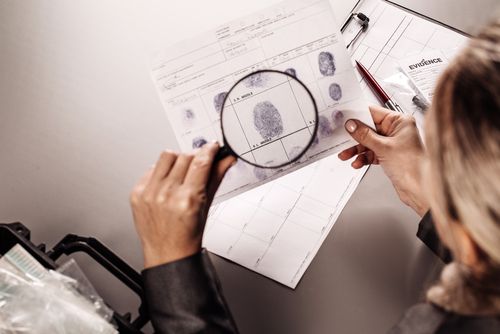Clients rely on their attorney’s knowledge of the law and their skills to help them win their personal injury case. One of the tools that the attorney relies on to do this is the presentation of “demonstrative evidence.” This includes things like pictures & videos, virtual demonstrations, models, and other types of objects presented by visual means.
Although there is much more technology used to present demonstrative evidence in court cases, the concept is not that new. From the time that primitive man used hieroglyphics on the side of cave walls, humans have used diagrams as a means of communication. Not only are people more likely to retain information that is demonstrated visually; they are more likely to absorb it in the first place.
The average length of a person’s attention span is a fleeting 8 seconds! That means that when an attorney presents evidence to a judge or jury, they are only past the introduction before interest begins to dwindle. While this damages any type of legal case, it can be especially devastating to your personal injury case.
Do I Even Need a Personal Injury Lawyer?
The majority of personal injury claims get settled before they go to court. It is to the benefit of both sides to negotiate a settlement rather than take the chance on a decision by the court. People who enter into the process with the best personal injury attorney at their side still find the court portion of the process overwhelming.
In many cases, the person isn’t aware of the common tactics used by insurance companies. Their goal is not to help you, the victim. It is to pay as little as possible. Your personal injury attorney knows what your claim is worth and what the insurance company will do to avoid paying it. He will either get a good settlement for your claim or prepare to go to court. In either event, you will benefit from the guidance of a good personal injury lawyer who is familiar with your case.

What Happens If My Case Goes to Court?
Both sides will present evidence about the accident that caused your injury and the impact it has had on your life. The potential medical treatment and loss of wages you are likely to encounter in the future will also factor into your claim. Keep in mind that while your attorney tries to convince the court that your injuries are serious, the other side will try to discredit you.
Your attorney has a few goals in mind in the courtroom. First, he must prove that the accident caused your injury and that it is just as serious as you stated in your claim. He must also prove the losses you have incurred as a result. Finally, it is the job of your personal injury attorney to prove that the other person or entity is at fault for the accident, either from negligence or willful attempt. It is virtually impossible to accomplish all of these goals through the audio presentation of facts.
A personal injury attorney who skillfully presents demonstrative evidence is a valuable asset. If you have never been in the courtroom, you don’t know how boring it can be. Each side drags on and on, talking about the same points repeatedly, often boring jury members to the point of sleep.
Jurors get restless and miss details that matter to your case. They only absorb a small part of what is said by either side, forgetting the majority of that soon after.
Because people are visual and “seeing is believing” the attorney who uses visual aids to get his point across will have a great deal more success. Generally, evidence is legally classified as either demonstrative, testimonial, or real. You can use each type of evidence to describe the same event but with a different impact on the jury.
Testimonial Evidence – Testimony is spoken by a witness in the courtroom or read from a deposition that was given prior to court. Sometimes recorded testimony is played for the court. Testimony may be provided by a witness who saw the accident. It is sometimes given by an “expert witness” who has credentials in a related area of the case but who wasn’t present at the time of the accident. In any case, testimony is always presented as an audio statement.
Real Evidence – Real evidence refers to items physically presented in court where jurors can view and/or inspect them. In a personal injury case, the real evidence might be anything from a faulty device to a rotted piece of wood.
Demonstrative Evidence – As we’ve already described it, evidence that is demonstrative is something visual. Although real evidence is also visual, that which is demonstrative serves to help the jurors understand how the accident or injury occurred.
A Comparison of the Different Types of Evidence
Let’s consider the types of evidence that your attorney might present after you suffer a back injury from a car accident. Remember, the lawyer must prove that the accident caused the injury, that the injury wasn’t pre-existing, and that the other person was at fault.
A witness might present testimony that the other driver went through a red light and struck your car. The damaged front end of the other driver’s vehicle where it struck your car might arguably be considered real evidence.
Demonstrative evidence might include a graphic re-enactment of the accident with all the actual conditions factored in. Insurance companies use these programs frequently to determine whether the driver was operating their vehicle legally at the time of an accident or to determine fault.
Although you may call a doctor to provide expert testimony, they can also use medical records such as x-rays, skeletal models, and other diagnostic results to give demonstrative evidence of the injury.

Forensic Evidence Is Demonstrative Evidence
Since the discovery of DNA testing methods in the 1980s, the field of forensics has grown exponentially. Today, all types of forensic evidence are presented in court to prove guilt and innocence, even in decades-old cold cases and false imprisonments.
When a personal injury is so severe that it results in a person’s death, it becomes a wrongful death. A wrongful death case is pursued in the same way as a personal injury except that a loved one has the right to file a claim.
When one person’s negligence results in the death of another, forensic evidence is often used to prove that the other party is at fault. For example, photos of the damage caused by the accidents, traffic signs, or video reenactments can prove that the conditions of the accident were directly responsible for the injury and resulting death.
The Process for Introducing Demonstrative Evidence
Before any evidence can benefit you, your attorney must get it in front of the jury. The presentation of demonstrative evidence isn’t something that your lawyer just “springs” on the jury. He must first prove to the judge that the evidence he wants to present provides a fair and accurate representation of the facts in the case. It is up to the court whether the evidence in question has value to the case and is relevant enough to present to the jury.
The main idea behind demonstrative evidence is not to shock or disturb the jury. It is a type of supportive evidence that makes it easier for them to understand the issues of the case. Overall, the evidence should educate, inform, and simplify the information presented through other means. Only if it meets this definition will the court rule the evidence as admissible and allow your attorney to present the evidence to the court.
The Most Popular Methods of Demonstration
While technology is not responsible for the idea of presenting demonstrations as evidence in court, it has given counsel many more options for presenting it. The most common forms include photos, slides, and x-rays.
It is often said that “A picture is worth a thousand words.” A personal injury attorney might argue that the right picture is worth a great deal more than that! Visual demonstrations are powerful tools that make a lasting impression on the jurors’ minds.
Due to the burden of proof related to the injury, personal injury lawyers often rely on x-rays to demonstrate the true extent of their client’s injury. After all, it is much easier for a juror to digest the severity of a broken bone when they see it instead of simply hearing a witness say “He has a broken leg as a result of the accident.”
Personal injuries differ greatly in severity and in the impact they have on the victim’s life. Sometimes what begins as a cut or fracture develops into an infection or other type of trauma. Some people lose wages while they heal and others lose their ability to work for an income for the remainder of their lives.
Verbal persuasion is not likely to impress any jury member; especially when they stop paying attention long before the story unfolds. Even the most severe injury doesn’t sound as serious when described with words as it does with pictures and medical imaging. Although demonstrative evidence primarily gives clarity instead of substantive evidence, it is often the factor that makes the injury seem real.
The Role of Demonstrative Evidence
It’s easy to see the importance of demonstrative evidence in your personal injury case. What may not be as clear is where your attorney gets the evidence to present in court. A lot of the photos and medical imaging results from the steps you take.
If possible, always take photos of the accident scene immediately after it occurs. Whether it is a car accident, a fall on a broken sidewalk, or something completely unexpected, you may need the photos as evidence if you file a personal injury claim. If faulty construction or a device that didn’t work caused the accident, get photos and any other evidence you can get to use as real evidence.
Try to get names and contact information of witnesses to present testimony on your behalf. You can back any evidence presented with witness testimony to strengthen your case.
Always get medical treatment even if you don’t think you are seriously injured. Some injuries don’t occur for hours or even days after an accident. The adrenaline released by your body can dull the pain and fool you into thinking you are fine. It’s also important not to tell anyone at the accident scene or from the insurance company that you are fine. If you find out afterward that you have an injury, the other side can use your statement against you.
Make sure your medical providers document all of your medical tests and treatments. Follow all of your doctor’s advice and get any tests recommended. This is partly to ensure you get the medical treatment you need for your injuries. It’s also going to provide your attorney with a source of images and medical records to use as demonstrative evidence in your case.
Having a skilled personal injury attorney on your side is important from the start. He knows the types of evidence you need to prove your case and collect the compensation you deserve. Even if you settle your case before it goes to court, you need to prepare for litigation from the time your injury first occurs. If your case progresses to the courtroom, you’ll have a lawyer who is already familiar with the facts of your case to fight for your rights.
Batta Fulkerson is a San Diego personal injury law firm with a successful record of negotiating and litigating for our clients. We know what it takes to get you a fair settlement and to make the most of your day in court.
Contact Batta Fulkerson to schedule your free initial consultation to get an evaluation of your case. Our attorneys have the skills and the dedication to get the best results for you and the changes your injuries have made to every aspect of your life.




